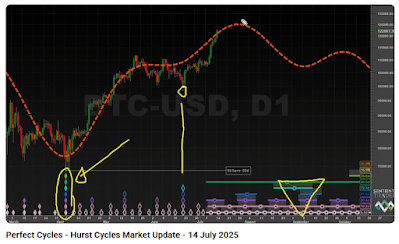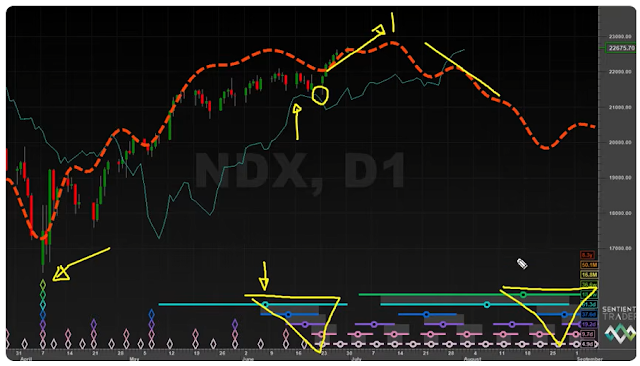The 40-week cycle, also known as the 9-Month Cycle, is a cornerstone of J.M. Hurst’s Cyclic Theory, developed during the 1960s and 1970s to forecast financial market movements through harmonic cycles. Spanning approximately 272.8 days from trough to trough, it consists of two 20-week cycles (19.48 weeks or 136.4 days each). The 40-week cycle is additionally subdivided into four 10-week or 80-day cycles (68.2 days), eight 40-day cycles (34.1 days), sixteen 20-day cycles (17 days), thirty-two 10-day cycles (8.5 days), and sixty-four 5-day cycles (4.3 days), forming one nested structure essential for swing and position trading.
This idealized 40-Week Cycle (purple) of 272.8 calendar days is divided into two 20-week cycles (teal), each
of which is further divided into two 10-week cycles (blue), highlighting the complete nested harmonic structure.
Note that the 40-week cycle is itself half of the 18-month cycle, which in turn is one-third of the 54-month cycle—half of a 9-year cycle—and so on. The 40-week cycle’s intermediate-term horizon captures significant market swings, making it ideal for timing entries at troughs and exits at peaks, especially when aligned with shorter cycles (10-week, 20-week) or longer cycles (18-month, 54-month). of which is further divided into two 10-week cycles (blue), highlighting the complete nested harmonic structure.
In bear markets, the cycle’s crest occurs early (second to third month, left translation), with a brief rise and prolonged decline; in bull markets, the crest shifts later (sixth to eighth month, right translation), leading to a longer advance. The strongest rallies typically occur in the first three months when cycles align upward, while the last three months are vulnerable to renewed declines.
Why the turning points of individual long-term cycles typically diverge—often significantly—from the composite
or summation cycle of the three to four most prominent cycles (red), and thus from actual market price extremes.
or summation cycle of the three to four most prominent cycles (red), and thus from actual market price extremes.
Hurst's nominal model allows for significant variability in actual cycle lengths.
Hurst's Nominal Model can be displayed as a series of sinusoids (x-axis) with different amplitudes (y-axis) that, when summed, create a composite model, represented by the thick black line in the example of an 18-month cycle projection for the current S&P 500 in the chart below.
The orange line is the 18-month cycle (17.93 months = 546.6 calendar days), the light green the 40-week cycle (9 months = 38.97 weeks = 272.8 days), dark green the 20-week component (4.5 months = 19.97 weeks = 136.4 days), light blue the 10-week cycle (= 68.2 days), dark blue the so called 40-day or 5-week cycle (= 34.1 days) and finally the so called 20-day cycle (17 days) is the purple sinusoid. The X axis represents the number of calendar days.
40-week cycle troughs are estimated for early 2026 and late Q4 2026.
The
wavelengths in the above S&p 500 projection are average values rather than exact measurements. The
thick black composite line ignores the effects of both the trend and
cycles shorter than 20 days or longer than 18 months. Assuming the US
stock market operates with clockwork precision, the dates for upcoming peaks and
troughs were
calculated from the 18-month cycle trough on April 7, 2025, and the
aforementioned average cycle lengths.
is projected to peak on August 19, 2025, according to Sigma-I.net.
See also:
.png)
.PNG)
%2018-month%20and%2054-month%20cycle%20peaks%20and%20troughs.PNG)




































